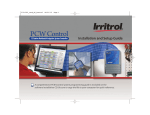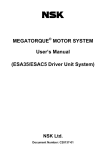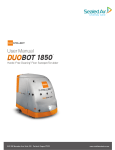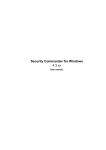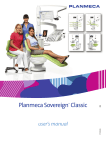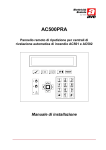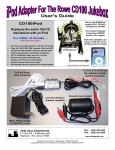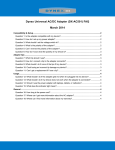Download Manual
Transcript
Test Equipment Depot - 800.517.8431 - 99 Washington Street Melrose, MA 02176 - TestEquipmentDepot.com INSTRUCTION MANUAL CD100A Introduction International Symbols The CD100A Combustible Gas Leak Detector is capable of sensing many combustible, non combustible and toxic gases that include but are not limited to the following: Acetone Alcohol Ammonia Benzene Butane Ethylene Oxide Gasoline-Petrol Halon Hydrogen Sulfide Industrial Solvents Jet Fuel Lacquer Thinners Methane Naphtha Natural Gas Propane Refrigerants Toluene NOTE: This leak detector is factory calibrated for methane in air. Operating Instructions 1. Turn the instrument on by rotating the thumwheel downward in a non-contaminated environment (fresh air). WARNING! This unit should not be used for detection of Carbon Monoxide. Features include • Fully adjustable steady tic rate accelerates as the sensor tip approaches a leak (the adjustment knob is located on the side of the unit) • "Tip-Light" in sensor cover used to see around the are of leak in a dark environment • Long 18" flexible gooseneck • Audible and visual leak indicator • Low battery indicator and separate battery compartment for easy replacement • Power On light • Solid state semiconductor sensor provides instantaneous detection • Sensor cover to protect sensor • Ruggedized protective rubber boot • Socket for optional earphone • One year limited warranty Safety Tips Before using this detector, read all safety information carefully. In this manual the word "WARNING" is used to indicate conditions or actions that may pose physical hazards to the user. The word "CAUTION" is used to indicate conditions or actions that may damage this instrument. WARNING! Charging or discharging batteries may give off an explosive gas. Keep away from open flame and sources of ignition from the battery at all times. CD100A-MAN 2. The green power LED will be illuminated when the unit is turned on. If the battery level is low, the red LED will be steady and the tic will not be adjustable. The battery will need replacing. 3. Adjust to slow uniform tic rate with the use of the thumbwheel (approximately two tics per second). This sets the instrument to the background level. Start your testing by setting the instrument in fresh air. The red LED indicator will flash in correspondence with the tic rate. Allow about 10 seconds for the sensor to stabilize indicated by a steady tic rate. (It may require up to two minutes to stabilize). 4. The unit responds to gas with a variable audible tic sound. The audible tic increases in volume when exposed to gases with 50 parts per million or more. When gas is detected, the tic rate will increase, rotate the thumbwheel back to the steady tic, resetting the instrument to this new background level. Move the instrument into higher concentrations of gas (indicated by increase tic rate) until the leak is found. 5. The "Tip-Light" is used to see around the area of the leak in a dark environment. 6. When this instrument is used in noisy environments, look at the red LED, which flashes more rapidly as the tic rate increases. The optional earphone can be plugged into the side of the unit, if there is high background noise or the operator does not want to disturb other people. This also disables the speaker. 7. If the tic rate becomes uncontrollable, it may be necessary to change the sensor. 8. The detector will respond to some leak finding solution (soap), so use your detector first. If over exposed to some gases, the detector may take an extended period of time to return to normal. P. 1 Battery Replacement 1. Turn off the power and remove the battery case cover. 2. Remove and dispose of old 9V alkaline battery promptly in a manner consistent with disposal regulations. Always use a 9V alkaline battery. Ensure the polarity of the battery matches that shown in the compartment. 3. Replace the battery case cover. Replacement Parts Battery Replacement Sensor Replacement Sensor Cap AB10 RS1000 RS1010 Optional Accessories Headset Earphones Hard Carrying Case HE1000 AC501 Sensor Filter and Sensor Replacement The sensor is housed at the tip of the gooseneck assembly, and has a life of more than three years. To remove the sensor: 1. Turn the unit off. 2. Pull off the top half of the sensor housing. (Pushing to one side aids removal) 3. With care, move the "Tip-Light" LED to one side to gain access to the sensor (small silver can). 4. Unplug the sensor and replace it with a new one. NOTE: The sensor can be fitted in either one of two ways without affecting instrument operation. 5. Realign the LED, ensuring it sits above the sensor. 6. Replace the sensor cover, by pushing it firmly in place. Note the locating pin between the body and sensor cap. Specifications Power supply: 1 x 9V battery Sensor: Solid state semi conductor Sensitivity: < 50 ppm methane Indicators: Audible: Adjustable tic rate Visual: Flashing LED Warm-up: 10 seconds Response Time: Instantaneous Duty Cycle: Continuous Battery Life: 5 hrs. typical use Dimensions: 8" (H) x 4" (W) x 1/2" (D) Weight: 205mm x 100mm x 36mm Probe Length: 15oz. / 400mm Operative: 0 - 50˚C / +32 - 122˚F Electromagnetic Compatibility The European Council Directive 89/366/EEC requires that electronic equipment does not generate electromagnetic disturbances that exceed defined levels and has an adequate level of immunity to enable it to be operated as intended. The specific standards applicable to this product are detailed in the appendices. Since there are many electrical products in use that pre-date this Directive and may emit electromagnetic radiation in excess of the standards defined in the Directive, it may be appropriate to check the analyzer prior to use. The following procedure should be adopted: 1. Go through the normal start sequence in the location where the equipment is to be used. 2. Switch on all localized electrical equipment that might cause interference. 3. Check that all readings are as expected. (Generally, a low disturbance is acceptable.) If not, adjust the position of the instrument to minimize interference or switch off the offending equipment during the test. There has been no awareness of any field based situation where such interference has ever occurred since the writing of this manual (April 1998). This advice is only given to satisfy the requirements of the Directive. This product has been tested for compliance with the following generic standards, and it is certified to be compliant. EN 50081-1 EN 50082-1 Specifications EC/EMC/K1/CD100A details the specific test configuration, performance and conditions of use. Protection against electric shock in accordance with EN 61010-1: 1993 This instrument is designated as Class III, SELV. CD100A-MAN P. 2 CD100A Combustible Gas Leak Detector Limited Warranty The CD100A is warranted to be free from defects in materials and workmanship for a period of one year from the date of purchase. If within the warra n ty period your instrument should become inoperative from such defects, the unit will be repaired or replaced at UEi’s option. This warra n ty covers normal use and does not cover damage which occurs in shipment or failure which results from alteration, tampering, accident, misuse, abuse, neglect or improper maintenance. Batteries and consequential damage resulting from failed batteries are not covered by warra n ty. Any implied warranties, including but not limited to implied warranties of merchantability and fitness for a particular purpose, are limited to the express warranty. UEi shall not be liable for loss of use of the instrument or other incidental or consequential damages, expenses, or economic loss, or for any claim or claims for such damage, expenses or economic loss. A purchase receipt or other proof of original purchase date will be required before warra n ty repairs will be rendered. Instruments out of warra n ty will be repaired (when repairable) for a service charge. Return the unit postage paid and insured to: This warranty gives you specific legal rights. You may also have other rights which vary from state to state. 99 Washington Street Melrose, MA 02176 Phone 781-665-1400 Toll Free 1-800-517-8431 Visit us at www.TestEquipmentDepot.com PLEASE RECYCLE Copyright © 2007 UEi CD100A-MAN 1/07







